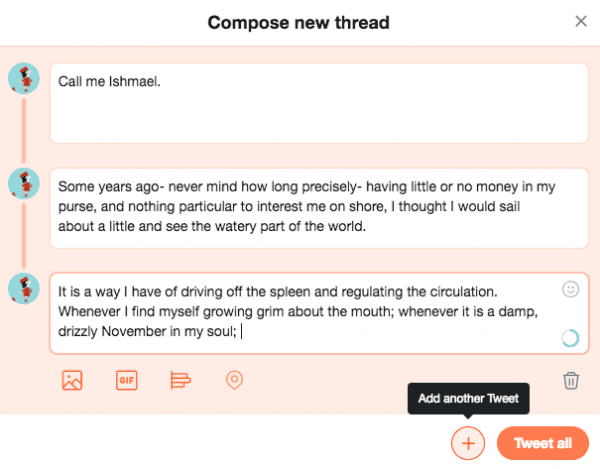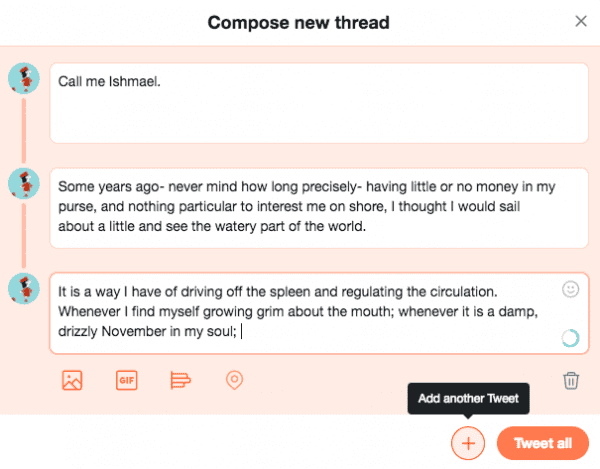
This week, Twitter unveiled a new and important feature — the ability to quickly and easily add tweets directly to a thread (a.k.a. a tweetstorm) without having to reply to yourself, and to publish multiple tweets within a thread at once.
The response from users so far has been generally limpid — perhaps because we’re all tuckered out from yelling about the site’s recent implementation of 280-character tweets.
Though the change is subtle, it demonstrates that Twitter is recognizing just how much it has evolved away from the “microblogging” element that was once so central to its culture — and how much its users have driven its cultural shift toward longform tweeting.
Twitter’s new threading interface is simple: just add a tweet
Twitter launched the threading function to all users on Tuesday, December 12. Now, anytime you start writing a tweet, you have the opportunity to turn it into a thread by clicking a new “plus” sign to bring up more tweet windows.



You can add as many tweets as you like, and when you’re done, you can “Tweet all.” You can also go back at any time to add more tweets to a thread you’ve already published.
The new display should make it much easier to actually read and write threads. It’s a pretty slick function — though most Twitter users seem to ignoring it. Among the few with opinions, a surprising number of reactions seem to be mostly positive, for once — though many are side-eying it, just as many people were skeptical of Twitter’s recent increase of its character limit from 140 to 280.
“Perhaps soon our tweets will just be the length of Medium posts,” opined one journalist in response to the change.
The new threading interface might not transform Twitter into a giant longread, but it could at least streamline the platform’s recurring thread display issues so that now you can see all replies in a thread in one easy-to-read flow. Hopefully, that will mean a better threading experience for all.
The change shows how Twitter’s users have forced the site to evolve
Beyond Twitter’s obvious attempt to improve the logistics of posting threads, the new function is also undoubtedly strategic. In an era when the president of the United States is one of Twitter’s most provocative, high-profile users, and when the site has become a go-to place for many cultural commentators to share their observations and opinions, the company seems particularly interested in giving people more and more ways to write longer posts and spend more time doing so.
Twitter’s recent doubling of its per-tweet character limit can be seen as an initial response to threads — people were clearly using them as a workaround for 140-character tweets, so why not let them pack more words into each one? — but it was also a simple way to increase the time and energy people spend on Twitter. The new threading function is essentially an extension of that mindset.
It isn’t perfect. For instance, with particularly long threads (like this massive 300-tweet entry that I’ve been updating intermittently since July), when you click on the first tweet, Twitter will only display the first 200. When you click on the most recent tweet, you can only see a few tweets back. Lost in the middle are about 75 tweets that are essentially totally inaccessible.
Most people probably won’t be using the function to build 300-tweet threads over a six-month period. But then again, maybe they will be: endless threads/tweetstorms built around the “1 like = 1 tweet” meme, like mine, are increasingly popular. Such a trend clearly demonstrates how much Twitter culture is shaped by users’ modifications and workarounds to its preestablished format.
Twitter users have completely and indelibly changed the platform over the years: In addition to that social media gamechanger, the hashtag, they’ve engendered the commonplace use of searchable reaction .GIF databases, threaded tweetstorms, Twitter-based meme culture, and so much more. It’s easy to eyeroll at Twitter’s enhanced threading as just another needless change to the site, but it’s also important to note that the change reveals how Twitter is observing the way that people actually using the site, and making adjustments accordingly.
In other words, if Twitter is moving away from the short, pithy statements that were once its claim to fame, it’s because we wouldn’t stop talking.
Sourse: vox.com






